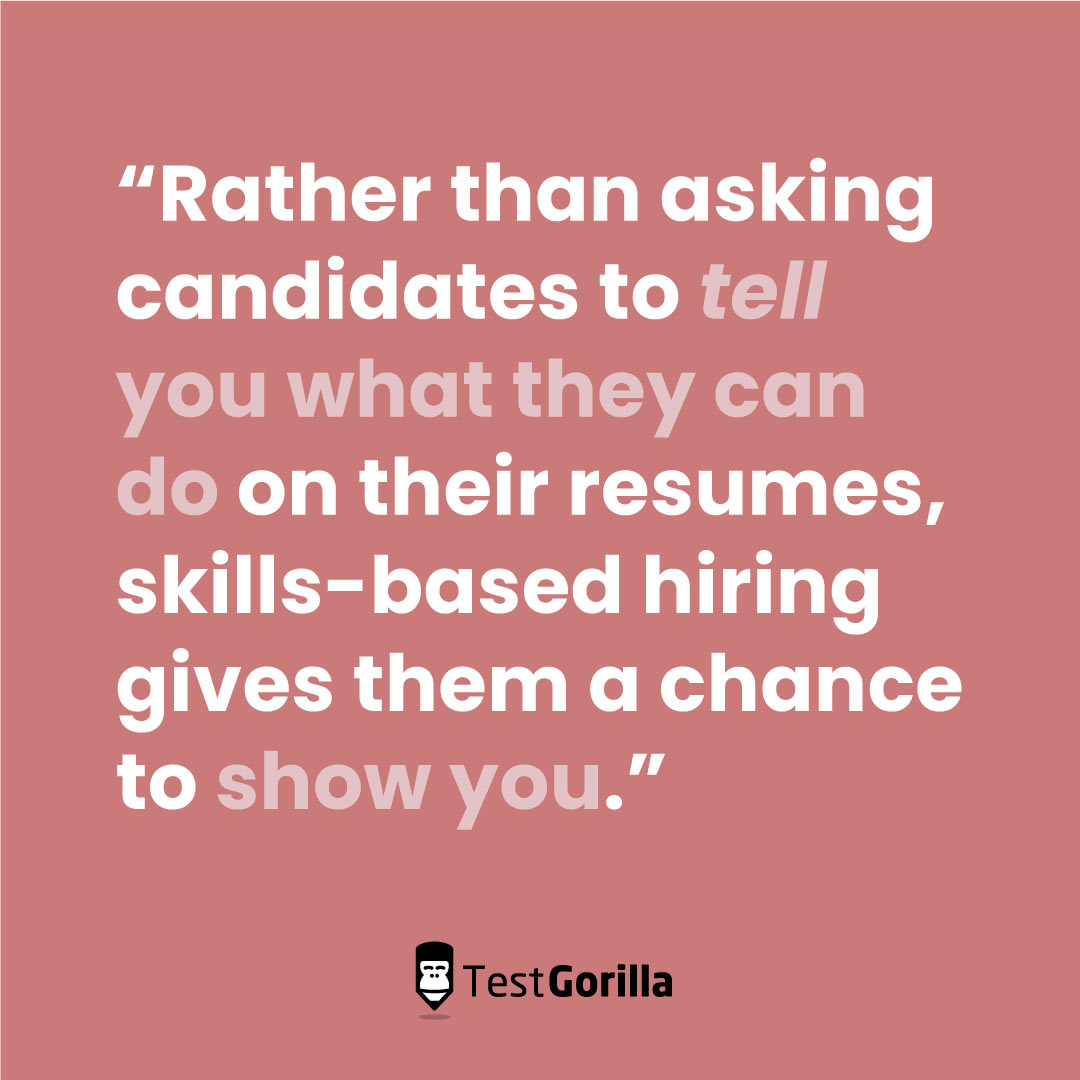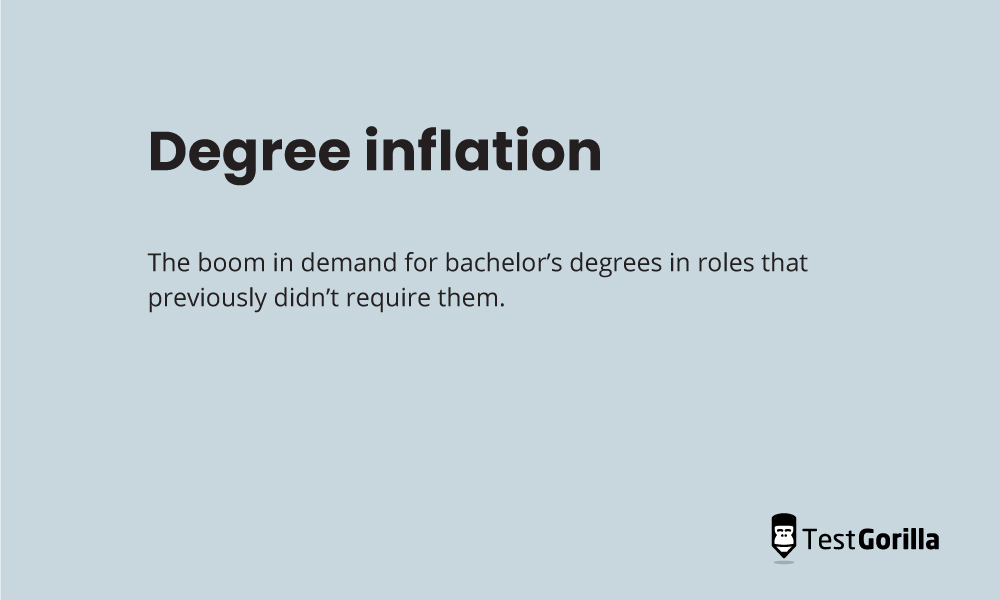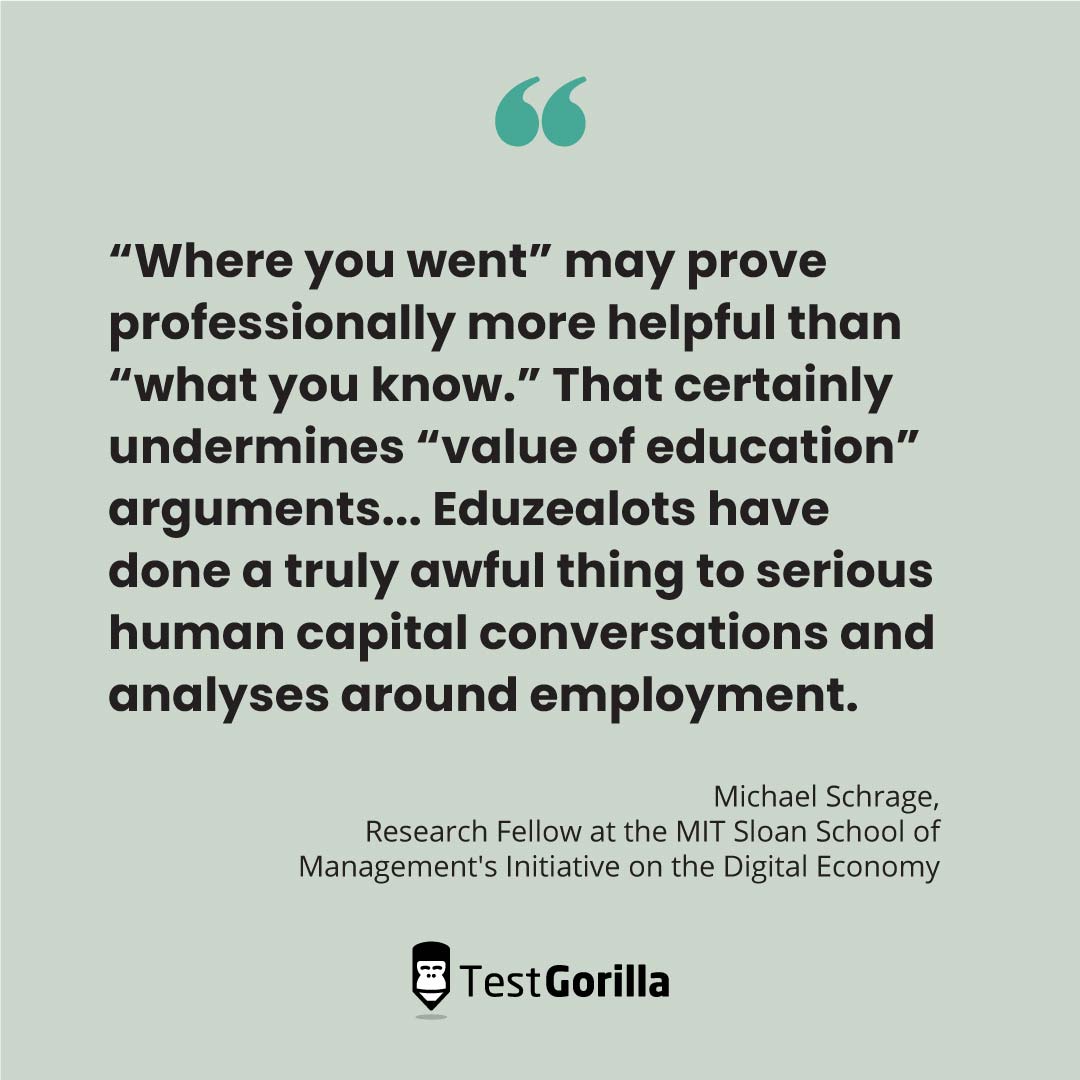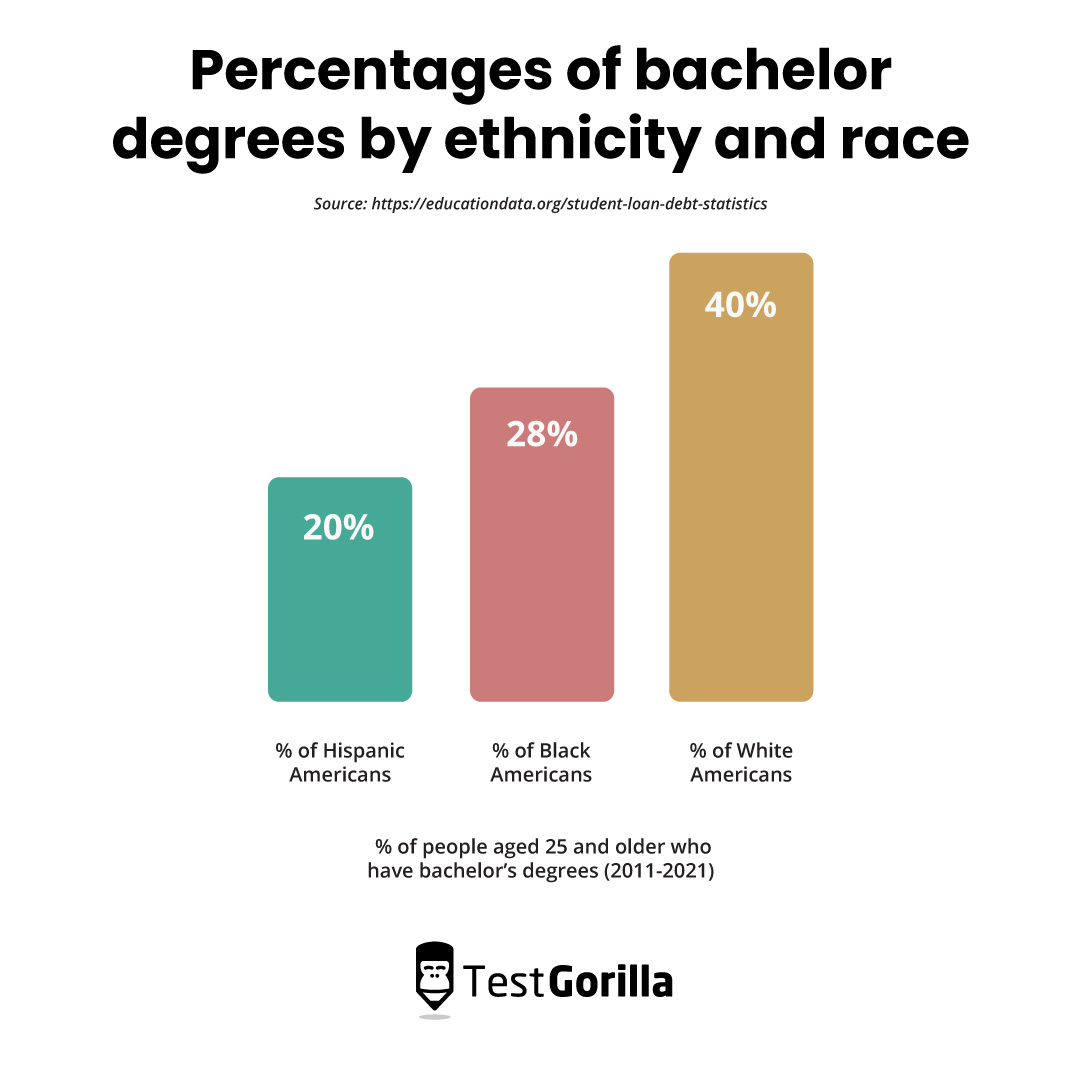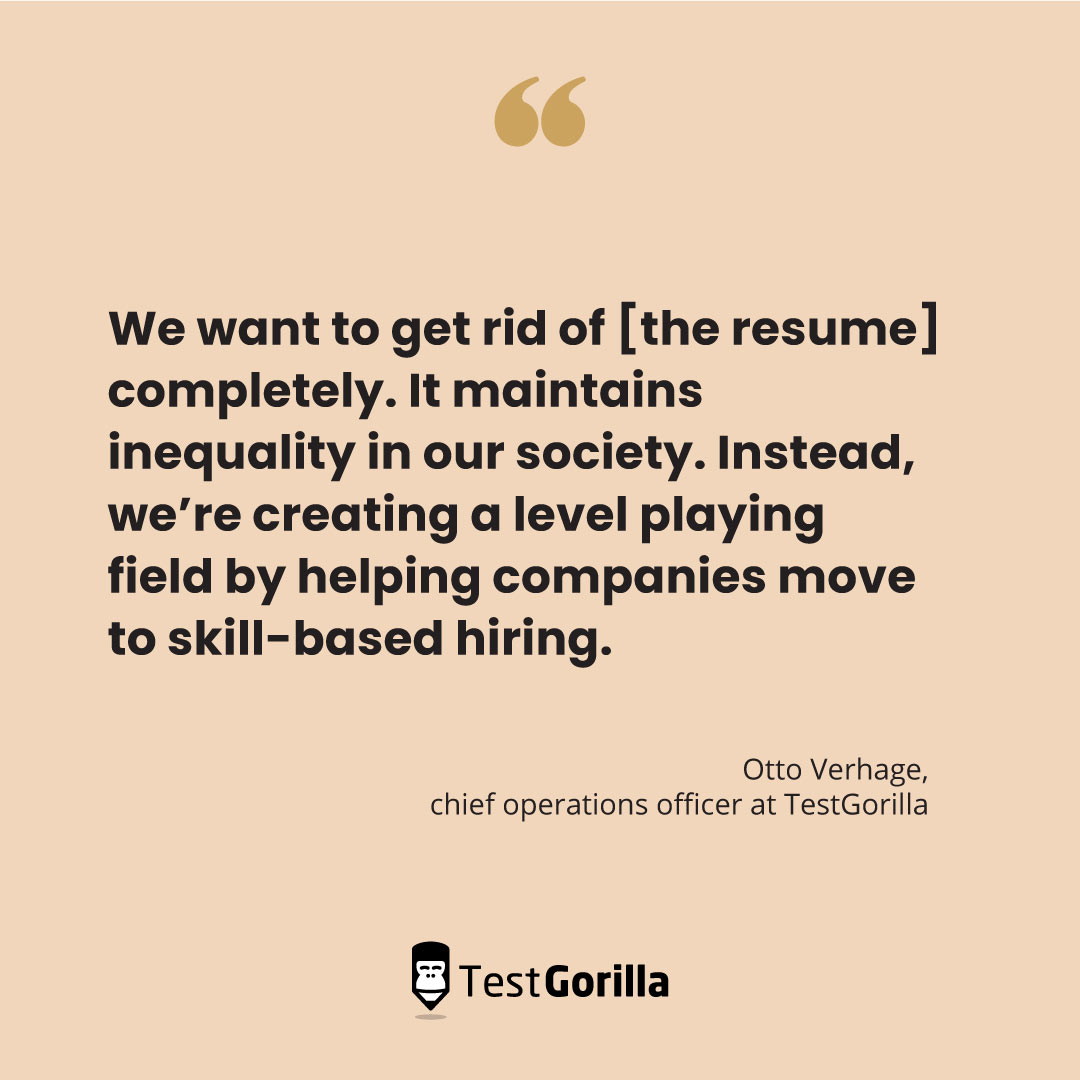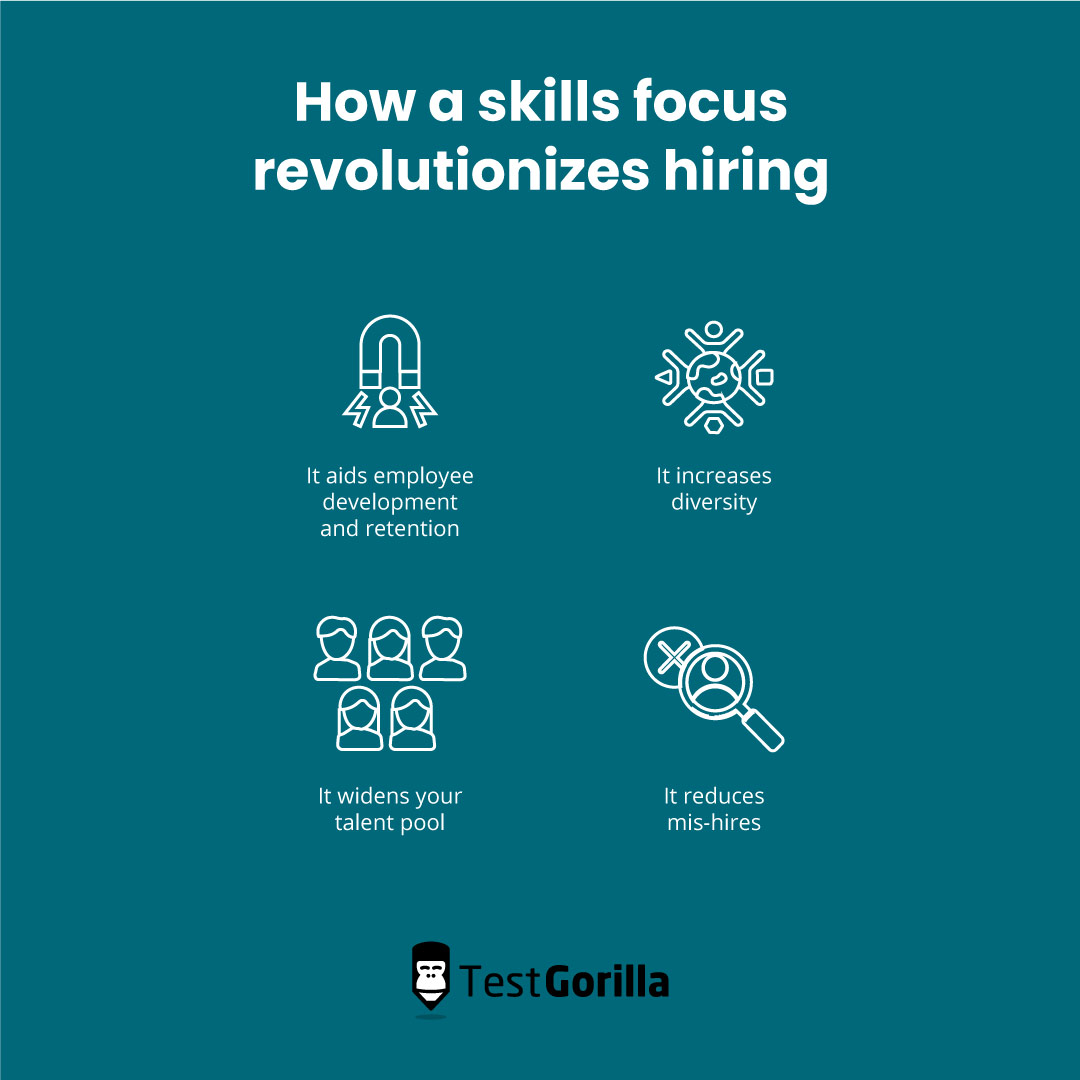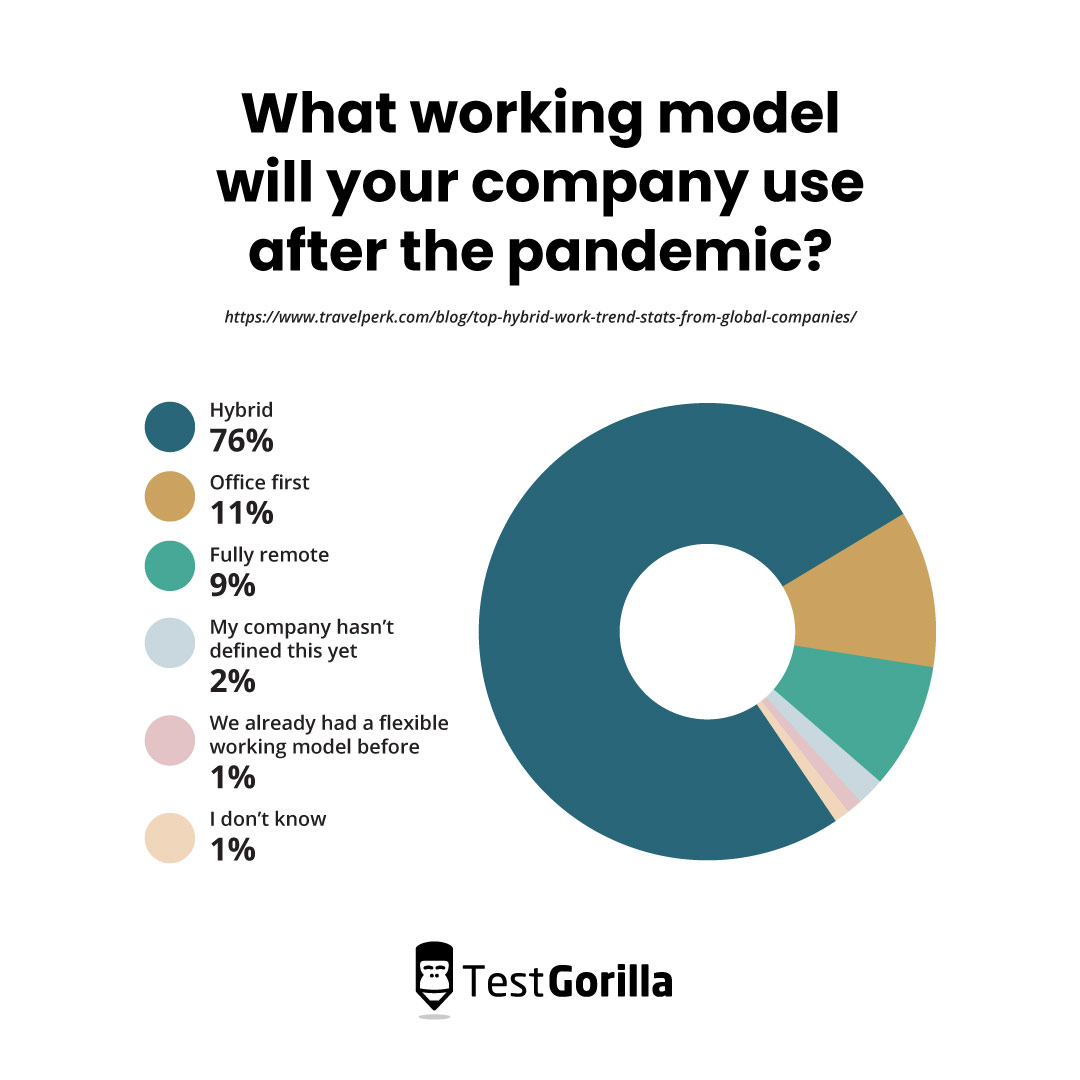Most HR leaders are aware of skills-based hiring, the recruitment practice that’s shaking up how we look at talent acquisition.
If they’re not already, they will be. Forbes named skills-based hiring one of the top recruitment trends for 2023, and it’s touted by many – including us at TestGorilla – as a faster, more effective way to find great talent.[1]
The reasons are simple, really. With traditional hiring, if you wanted to find a candidate with great critical thinking skills, you had to ask questions like, “How many ping pong balls fit in a 747?” Now, you can give a simple online critical thinking test.
But where has this sudden interest in skills-based hiring come from, and what does it mean for your workforce? In this blog, we’ll look at the rise of skills-based hiring over the past few decades and what it means for the future of recruitment.
Table of contents
How does skills-based hiring differ from traditional hiring?
We all know what traditional hiring looks like. In a nutshell:
Resumes. Lots and lots of resumes.
Applicant tracking software that screens out candidates based on criteria like education level, years of experience, or even particular keywords in their profile.
Unstructured interviews that don’t always probe the key skills required by the role.
At TestGorilla, we believe this system is broken.
Skills-based hiring is the best alternative. It recommends that instead of starting the hiring process by asking candidates for resumes and stipulating degree and experience requirements, employers instead simply administer pre-interview assessments.
Rather than asking candidates to tell you what they can do on their resumes, skills-based hiring gives them a chance to show you.
The skills-based hiring approach also recommends replacing unstructured interviews with structured interviews – a favorite tactic of hiring managers at Google.[2]
While traditional interviews often involve hiring managers improvising different questions for each candidate with few prior benchmarks in place for assessing their answers, structured interviews require them to decide what their questions will be beforehand and agree on what makes a “good” answer.
This makes it considerably easier to compare candidates and streamline recruiter decision-making.
Clearly, skills-based hiring is a radical departure from the way things have traditionally been done. But how did we come to need such a big change?
The rise of skills-based hiring
The concept of testing candidates before you hire them is by no means new. Mental tests were administered to potential recruits as early as the Han Dynasty in China, which dated from 206 BCE to 220 CE – and that’s just the earliest example we can find!
However, the rise of skills-based hiring as we understand it today has been shaped by a few distinct phenomena over the last thirty years. Let’s break down the recent history of hiring to understand where we’re at today and what to expect tomorrow.
Degree inflation
In the late 20th century, Western society began to shift from being an industrial society to what the economist Peter Drucker called a “knowledge economy”[3]; now, rather than the economy being driven by physical labor, it was driven by “knowledge work” made possible by the rise of information processing.
In this new environment where knowledge is king, degrees have become a convenient proxy for the kind of professional skills that are now a baseline for many jobs. These include skills in communication and presentation as well as basic competency in programs like Excel.
This has resulted in the phenomenon called degree inflation: The boom in demand for bachelor’s degrees in roles that previously didn’t require them.
In 2015, Harvard researchers found that 67% of production supervisor job ads asked for a college degree despite the fact that only 16% of currently employed production supervisors had one.[4]
With more and more jobs requiring a university education, many young people naturally flocked to colleges and universities. This intensified as the employment market became choppier with the 2008 recession particularly accelerating enrollment in university education.
Increased university enrollment continued into the 2010s with governments around the world touting higher education as the key to stable future employment. Examples include the “Reach Higher” initiative pushed by the Obama administration and the British Conservative Party government’s 2010 manifesto.
From 2011 to 2021, U.S. census data shows that the number of adults aged 25 or over with a bachelor’s degree or higher increased by 8-10% across many U.S. ethnic groups.
Not everyone was convinced this was a good thing, however. Cynicism about the usefulness of these degrees started to creep in around the mid-2010s. Michael Schrage, a Research Fellow at the MIT Sloan School of Management’s Initiative on the Digital Economy, expressed skepticism about the usefulness of higher education as early as 2010.[5]
“Eduzealots,” he theorized in his article, had over-inflated the value of college degrees. In doing so, they had undermined an important conversation about hiring for “street smarts” versus “book smarts.” He predicted that this boom in college degrees would inevitably lead to a harmful burst.
(Incidentally, he was also an early pioneer of skills testing, advocating that companies should require board members to complete personality tests before being hired.[6] Smart guy!)
Schrage’s suspicions soon proved correct.
Bursting the bubble of the four-year degree requirement
Soon enough, degree inflation started being noticed by more leading experts. Harvard research found that degree inflation created a degree gap particularly concentrated in “middle-skill” jobs affected by automation.
Where in the past someone might have done these jobs manually, middle-skill roles were increasingly mediated by machines and computers. Employers fell back on the four-year college degree as a sign that candidates could handle these digitized roles.
However, while seeming on the surface like a simple solution, the four-year degree requirement actually made it harder for employers to fill these roles with competent candidates, especially as the rate of technological change continued to increase.
Although most universities require that their students possess basic computer skills, the reality is that the mere presence of a degree on a resume is no true guarantee of this skillset.
There are many reasons for this. One is the simple variance between the quality of teaching at different institutions; another is that some degrees rely more heavily on computers than others. A liberal arts degree, for example, does not necessarily require that students develop Excel proficiency.
Web development is a good example of degrees not necessarily imparting the most useful skills. JavaScript is the most well-known coding language among developers, yet only 42% of student developers said they knew JavaScript.[7]
This inevitably led to skill shortages in the late 2010s. For companies, this meant increasing uncertainty. In 2019, for example, only 27% of small companies and 29% of large companies believed they possessed the right talent for digital transformation.[8]
For graduates, it meant that a degree was no longer as safe a bet for a secure and fulfilling job as it was once cracked up to be. By September 2022, almost 40% of recent college graduates in the United States found themselves underemployed.
All this was occurring against a backdrop of skyrocketing student debt. In 2023, the average federal student loan balance for graduates sat at $37,787! But those saddled in debt were lucky enough to get a college degree in the first place.
Educational inequality greatly affects college outcomes. Although, as we’ve seen, 2011-2021 census data does show increases in enrolment across ethnicities in the last decade, only 20% of Hispanic Americans and 28% of Black Americans aged 25 and older had bachelor’s degrees from 2011 to 2021, compared to over 40% for non-Hispanic White Americans.
It wasn’t until the Covid-19 pandemic that all of these problems were thrown into overdrive.
Amid the pressures of lockdown, inequality worsened at all stages of the educational pipeline, a disruption that will have knock-on effects for years to come,[9] and the number of students attending college dropped by 2.5% from 2020 to 2021.
At the same time, the Great Resignation was fuelling skill shortages across sectors. Some 4.3 million people reportedly quit their jobs,[10] with certain industries hit harder than others. An MIT study found that the attrition rates from layoffs, resignations, and retirements were at their highest in apparel retail and management consulting.
Traditional hiring was in a crisis of its own making. It was time for skills-based hiring to take the stage.
Shifting the focus to skills
Skills-based hiring has been on the move in earnest since the mid-to-late 2010s, as seen in the success of projects like the TechHire initiative, which funded skills-based organizations such as Opportunity@Work.[11]
With the traditional requirement for a four-year degree not delivering on its promises, and the Covid-19 pandemic forcing many companies to not only switch to remote and hybrid work but seek out more cost-effective solutions for old challenges. Leaders were finally looking for radical solutions.
One of those leaders was our co-founder, Otto Verhage.
Otto was in charge of hiring for a position at Bain and Company when the pandemic hit. Remote work removed geographical barriers to the role, but although this gave him a wider array of talent to choose from, he found himself frustrated by the deluge of resumes.
Not only was sifting through resumes a huge time-sink, but Otto suspected they didn’t truly give him the information he needed about candidates to find the right match.
Otto saw an opportunity to lead the charge in making skills-based methods accessible to companies of all sizes through pre-interview testing. Together with Wouter Durville, he founded TestGorilla to give companies the information they actually need to make great hires.
“We want to get rid of [the resume] completely,” Otto told Silicon Canals in 2022. “It maintains inequality in our society. Instead, we’re creating a level playing field by helping companies move to skill-based hiring.”[12]
The solution has been taken up enthusiastically by companies across the globe: Since the epiphany from that first frustrating hire, we have raised over €75 million, hired 100 employees from all over the world, and helped over 8400 companies shift to skills-based hiring.
We’ve seen enough success stories to know the impact that skills-based hiring can have, but let’s briefly cover the biggest changes you’ll see in your business after switching to a skills-based approach.
How a skills focus revolutionizes hiring
Switching to a focus on skills in your hiring methods brings huge changes across your business.
Here are the top four:
1. It widens your talent pool
By throwing out the four-year degree requirement and other arbitrary filters on applicant tracking software, you naturally widen your candidate pool.
Pre-interview testing is accessible to any candidate anywhere with an internet connection and, when used as part of a dynamite remote hiring strategy, enables you to widen your talent pool geographically.
Crucially, it does this without coming at the cost of your hiring managers’ time. The system filters candidates based on their aptitude and fitness for the role, automatically shortlisting them for you without having to wade through a pile of resumes.
2. It increases diversity
Obviously, having a greater geographical range can help increase diversity. However, even if you only hire in your local area, pre-interview testing still promotes diversity within the hiring process.
Tests do this by narrowing the margin of human error and bias when it comes to shortlisting applicants. Whether you go for completely blind hiring or a more open approach, tests help you to anonymize applications up to the point of shortlisting, meaning that applicants cannot be discriminated against because of aspects such as their names.
This is more likely than you think: One study found that job applicants with White-sounding names were 9% more likely than those with Black-sounding names to receive responses from employers, even with the exact same applications.
3. It aids employee development and retention
Skills-based hiring can help you weather uncertainty by identifying and even anticipating skills gaps in your workforce, a phenomenon that 87% of companies say they are either already dealing with or anticipating within the next 5 years. You can then address these gaps proactively through upskilling initiatives.
This kind of proactive planning not only ensures the smooth running of your business but also improves employee satisfaction and your reputation with potential hires.
65% of workers believe opportunities for upskilling are very important when evaluating a potential new job, and 61% say it’s “extremely” or “very” important when deciding whether to remain at their current job.
4. It reduces mis-hires
It is only logical that the above benefits all contribute to avoiding the costly business of making a bad hire.
Skills-based hiring gets you recruits that are not only more competent but also more likely to last longer. In a study of 300,000 hires, employees who were hired with job testing stayed 15% longer in their positions than those hired without.[13]
What’s next for skills-based hiring?
In 2024, 81% of companies are using skills-based hiring, making it the number 1 way to hire. Its benefits for remote recruiting mean that it will still be a top choice for employers as they continue to embrace remote and hybrid working models post-pandemic.
Our other predictions for how skills-based hiring will change the recruitment landscape include:
More companies will axe the four-year degree requirement. We’ve already covered the damage these requirements do to your hiring processes, and with experts predicting that the number of college students will fall by more than 15% after 2025, we can expect to see this arbitrary requirement decline in popularity in the next few years.
Resumes will be replaced with skills assessments. We believe that by 2030, the resume will have become extinct as a first-round assessment tool for hiring managers to be replaced by sophisticated psychometric testing.
More leaders will focus on creating equality of opportunity in their hiring processes rather than equality of outcome. Attempting to meet a preset diversity quota is a highly controversial move with little proven success at combating prejudice. We believe that creating equal opportunities for employment and development has the most benefit for individuals and companies when it comes to reducing inequalities like the gender employment gap.
Step into the future of hiring with a skills-based approach to recruitment
It might seem excessive to give you such a detailed history of skills-based hiring, but we think there are real benefits to seeing the bigger picture.
As well as understanding the historic shift that skills-based hiring represents, it’s also a reminder to keep your eyes open to what’s going on in the world of recruiting to update your skills and knowledge for keeping your workforce on the cutting edge.
To bring your recruitment process into the future, read our guide to how to adopt skills-based hiring practices in your organization.
Nervous about making the switch? Read our blog about the barriers you’ll face on the road to skills-based hiring, and how to overcome them.
Or, if you simply can’t wait, find motivated candidates for your next open role using our online motivation test.
Sources
Meister, Jeanne. “Top Ten HR Trends For The 2023 Workplace”. (January 10, 2023). Forbes. Retrieved February 07, 2023. https://www.forbes.com/sites/jeannemeister/2023/01/10/top-ten-hr-trends-for-the-2023-workplace/?sh=182a2d225933
Bock, Laszlo. (April 2015). “Here’s Google’s Secret to Hiring the Best People”. WIRED. Retrieved January 5, 2023. https://www.wired.com/2015/04/hire-like-google/
Drucker, Peter F. “The New Society of Organizations”. (September – October 1992). Harvard Business Review. Retrieved February 07, 2023. https://hbr.org/1992/09/the-new-society-of-organizations
Fuller, Joseph; Raman, Manjari. (October 2017). “Dismissed by Degrees”. Harvard Business School. Retrieved February 7, 2023. https://www.hbs.edu/ris/Publication%20Files/dismissed-by-degrees_707b3f0e-a772-40b7-8f77-aed4a16016cc.pdf
Schrage, Michael. “Higher Education Is Overrated; Skills Aren’t”. (July 29, 2010). Harvard Business Review. Retrieved February 07, 2023. https://hbr.org/2010/07/higher-education-is-highly-ove
Schrage, Michael. “Board Members Should Have to Take a Personality Test”. (November 10, 2014). Harvard Business Review. Retrieved February 07, 2023. https://hbr.org/2014/11/board-members-should-be-psychologically-profiled-before-being-hired
“2019 HackerRank Developer Skills Report”. (2019). HackerRank. Retrieved February 07, 2023. https://www.hackerrank.com/research/developer-skills/2019
Snyder, Scott. “Talent, not technology, is the key to success in a digital future”. (January 11, 2019). World Economic Forum. Retrieved February 07, 2023. https://www.weforum.org/agenda/2019/01/talent-not-technology-is-the-key-to-success-in-a-digital-future/
“Years Don’t Wait for Them’: Increased Inequalities in Children’s Right to Education Due to the Covid-19 Pandemic”. (May 17, 2021). Human Rights Watch. Retrieved February 07, 2023. https://www.hrw.org/report/2021/05/17/years-dont-wait-them/increased-inequalities-childrens-right-education-due-covid
Iacurci, Greg. “4.3 million people quit their jobs in January as the Great Resignation shows no sign of slowing down”. (March 9, 2022). CNBC. Retrieved February 07, 2023. https://www.cnbc.com/2022/03/09/the-great-resignation-is-still-in-full-swing.html
“Our History”. Opportunity@Work. Retrieved February 07, 2023. https://opportunityatwork.org/our-history
“How Amsterdam-based HR-tech scaleup TestGorilla will get rid of the curriculum vitae for good”. (October 7, 2022). Silicon Canals. Retrieved February 17, 2023. https://siliconcanals.com/news/startups/testgorilla-will-get-rid-of-cv-for-good/
Hoffman, Mitchell; Kahn, Lisa B.; Li, Danielle. (November 2015). NBER. Retrieved February 7, 2023. https://www.nber.org/papers/w21709
Related posts
Hire the best candidates with TestGorilla
Create pre-employment assessments in minutes to screen candidates, save time, and hire the best talent.
Latest posts
The best advice in pre-employment testing, in your inbox.
No spam. Unsubscribe at any time.

Hire the best. No bias. No stress.
Our screening tests identify the best candidates and make your hiring decisions faster, easier, and bias-free.
Free resources
This checklist covers key features you should look for when choosing a skills testing platform
This resource will help you develop an onboarding checklist for new hires.
How to assess your candidates' attention to detail.
Learn how to get human resources certified through HRCI or SHRM.
Learn how you can improve the level of talent at your company.
Learn how CapitalT reduced hiring bias with online skills assessments.
Learn how to make the resume process more efficient and more effective.
Improve your hiring strategy with these 7 critical recruitment metrics.
Learn how Sukhi decreased time spent reviewing resumes by 83%!
Hire more efficiently with these hacks that 99% of recruiters aren't using.
Make a business case for diversity and inclusion initiatives with this data.

